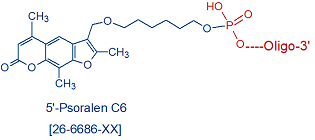
Modification : Psoralen C6-5'
Catalog Reference Number
Category
Modification Code
5 Prime
3 Prime
Internal
Molecular Weight (mw)
Extinction Coeficient (ec)
Technical Info (pdf)
Absorbance MAX
Emission MAX
Absorbance EC
26-6686
Intercalators
[Pso-C6-5]
Y
N
N
420.4
10.6
PS26-6686.pdf
-
-
-
| Catalog No | Scale | Price |
| 26-6686-05 | 50 nmol | $210.00 |
| 26-6686-02 | 200 nmol | $210.00 |
| 26-6686-01 | 1 umol | $280.00 |
| 26-6686-03 | 2 umol | $369.00 |
| 26-6686-06 | 5 umol | $810.00 |
| 26-6686-10 | 10 umol | $1,438.00 |
| 26-6686-15 | 15 umol | $1,797.00 |
| Discounts are available for Psoralen C6-5'! |
| Modification* Discount Price Structure |
|
1 site/order
|
List price
|
|
2 sites/order
|
10% discount
|
|
3 sites/order
|
20% discount
|
|
4 sites/order
|
30% discount
|
|
5-9 sites/order
|
50% discount
|
|
10+ sites/order
|
60% discount
|
|
*Exceptions apply
|
Psoralen C6 is a heterocyclic compound capable of intercalating between bases, and cross-link bases, in both double-stranded and triple-stranded DNA. It is attached to a C6 linker in order to facilitate a psoralen-modified oligonucleotide's ability to intercalate and cross-link with triple-stranded DNA. Psoralen is typically used as a ss/ds DNA intercalating or cross-linking reagent, for the purpose of probing nucleic acid secondary structure (1). Upon exposure to long wavelength UV light (350 nm), psoralen forms covalent cyclobutane linkages to thymidine. Psoralen can form two different types of adducts with thymidine. The first is a monoadduct, in which the psoralen moiety binds to one adjacent thymidine on the same or complimentary strand. The second is a diadduct, in which psoralen binds to two thymidines adjacent to it, either on the same or complimentary strand (2). Diadducts formed between adjacent thymidines are photo-reversable with short wavelength UV light (254 nm). In addition to cross-linking duplex DNA, Psoralen-C6 homopyrimidine oligos can be used to bind to a complementary homopurine-homopyrimidine duplex, to form a triple-helix that can then be cross-linked together at the triplex-duplex junction point (3). Psoralen-modified oligonucleotides are widely used as research tools; representative examples of such use are shown in these references (4,5).
References
1. Cimino, G.D., Gamper, H.B., Isaacs, S.T., Hearst, J.E. Psoralens as Photoactive Probes of Nucleic Acid Structure and Function: Organic Chemistry, Photochemistry, and Biochemistry.
Ann. Rev. Biochem. (1985),
54: 1151-1193.
2. Pieles, U., Englisch, U. Psoralen covalently linked to oligodeoxyribonucleotides: synthesis, sequence specific recognition of DNA and photo-cross-linking to pyrimidine residues of DNA.
Nucleic Acids Res. (1989),
17: 285-299.
3. Takasugi, M., Guendouz, A., Chassignol, M., Decout, J.L., Lhomme, J., Thuong, N.T., Helene, C. Sequence-specific photo-induced cross-linking of the two strands of double-helical DNA by a psoralen covalently linked to a triple-helix-forming oligonucleotide.
Proc. Natl. Acad. Sci. USA (1991),
88: 5602-5606.
4. Barre, F-X., Ait-Si-Ali, S., Giovannangeli, C., Luis, R., et al. Unambiguous demonstration of triple-helix-directed gene modification.
Proc. Natl. Acad. Sci. USA (2000),
97: 3084-3088.
5. Wang, X., Peterson, C.A., Zheng, H., Nairn, R.S., Legerski, R.J., Lei, L. Involvement of Nucleotide Excision Repair in a Recombination-Independent and Error-Prone Pathway of DNA Interstrand Cross-Link Repair.
Mol. Cell. Biol. (2001),
21: 713-720.
- Psoralen C6-5'
